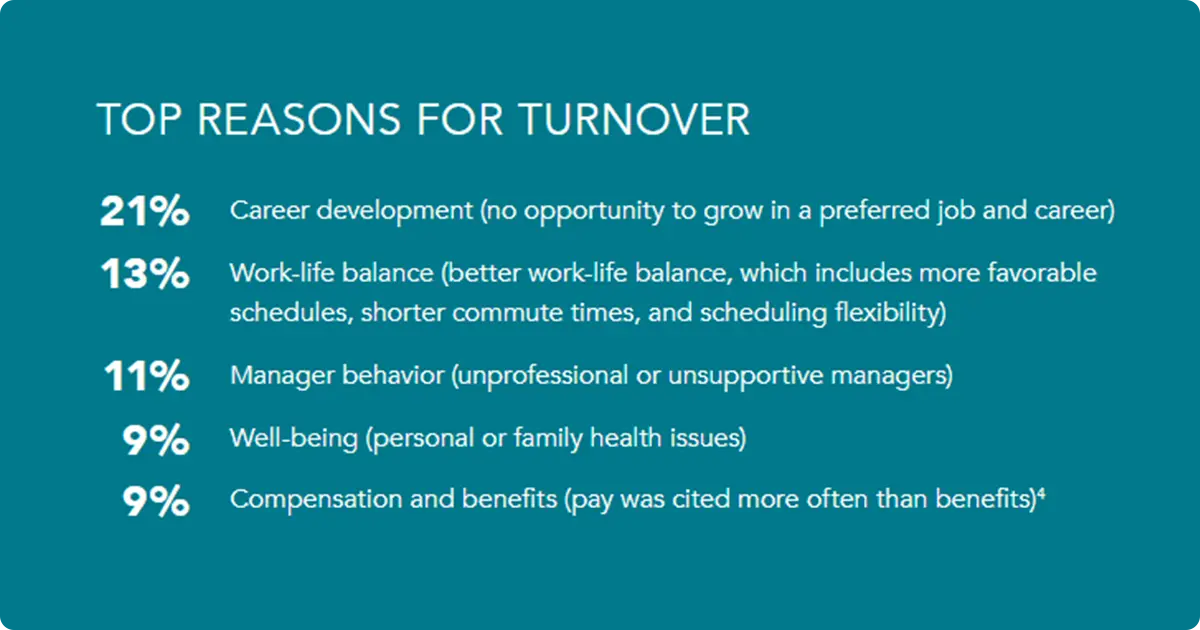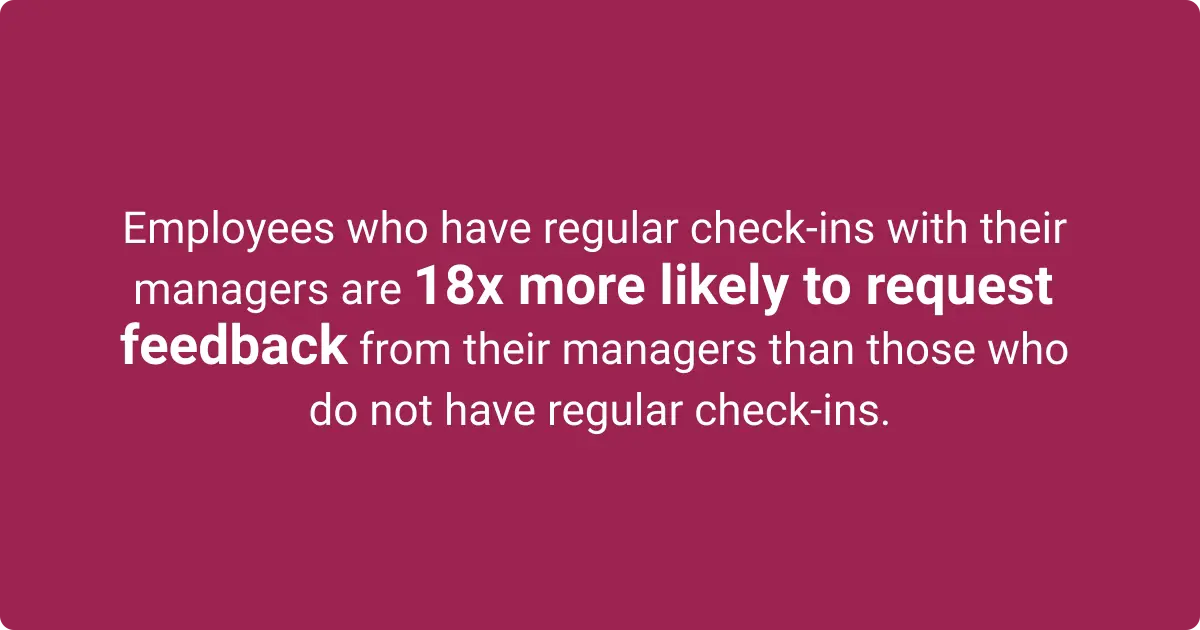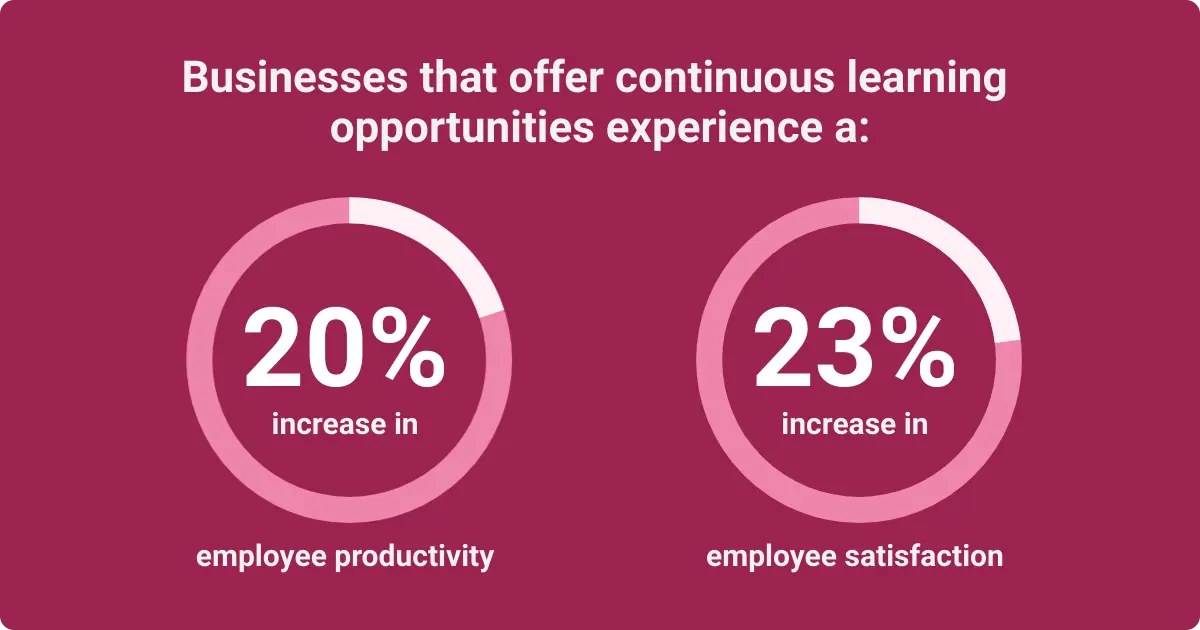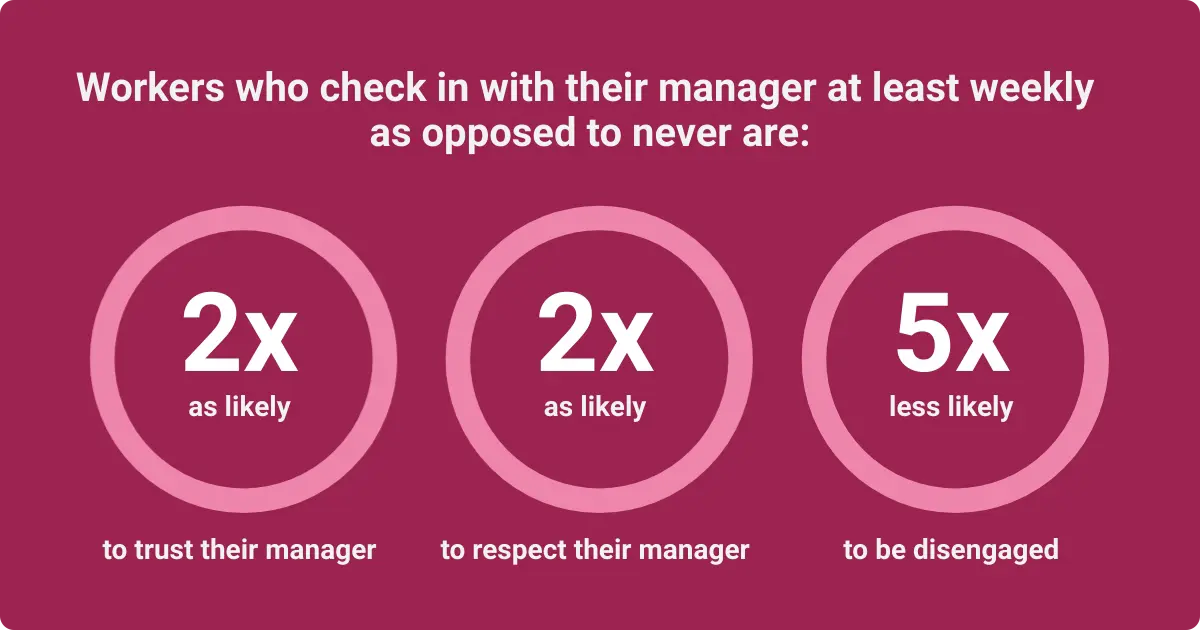Top Areas of Growth and Development for Employees

In today’s workplace, continuous growth isn’t optional - it’s a necessity. With 62% of employees expressing a desire for more feedback from their colleagues, it’s evident that supporting development is crucial.
How can you ensure your team is developing the key skills needed to thrive?
This article will explore the top areas of growth for employees, including communication, leadership, technical skills, emotional intelligence, and adaptability. We’ll provide clear strategies and valuable resources to help you foster these skills within your team.
Let’s dive into practical ways to create a culture of continuous improvement and ensure your organization stays ahead.
The importance of employee growth
Investing in employee growth is essential for the sustained success of any organization. When employees develop, the whole company thrives.
Here's why growth is critical for both individuals and organizations:
Why growth and development is essential:
- Enhanced performance: Organizations who provide their employees with the training needed to develop their skills are 17% more productiveOpens in a new tab. Encourage a continuous learning culture through workshops and courses.
- Increased engagement: A recent Better Buys survey of more than 2,000 employees about the impact of professional developmentOpens in a new tab found that employees with professional development opportunities are 15% more engaged. Implement regular training programs to keep your team motivated.
- Talent retention: Companies that offer professional development have a 34% higher retention rate. Provide clear career progression paths to retain top talent.
The cost of not investing in employee development:
- High turnover rates: Research from our "Increasing Employee Retention" guide found that a lack of development opportunities was one of the top reasons for employee turnover. The cost of replacing an employee can range from one-half to 3x of the employee’s annual salary. Prioritize talent development strategies to avoid these costs.

Want to learn more about inspiring loyalty and retaining top talent? Read this guide for compensation and benefits professionals.
- Stagnation: Without development, employee skills can become outdated, leading to a 23% drop in company revenueOpens in a new tab. Stay ahead by regularly updating training materials.
- Low morale: 45% of employeesOpens in a new tab look for new jobs when they don't see growth opportunities. Foster a culture of continuous improvement to keep morale high.
Benefits of focusing on areas of development:
Innovation and adaptability: By ensuring employees focus on the skills needed for a job, organizations can drive innovation and adaptability. According to Deloitte’s Leading in LearningOpens in a new tab report, companies that invest in continuous learning are 92% more likely to introduce innovative solutions. Encourage creative thinking and problem-solving exercises.
Leadership pipeline: Developing internal leadership skills reduces the need for external hires by 25%. Offer leadership training and corporate mentorship programs.
Competitive advantage: Companies prioritizing employee growth are 46% more likely to be market leaders. Stay competitive by investing in your team’s development.
To create a culture of continuous improvement, implement regular employee training and development programs, conduct a comprehensive talent inventory, offer clear career progression, and foster creative thinking. Let’s delve into the key areas where this growth can make the biggest impact.
Key areas of growth examples for employees
Communication and active listening skills
Effective communication and active listening are essential job-related skills that form the cornerstone of a successful workplace. They ensure that information flows smoothly, teams collaborate efficiently, and misunderstandings are minimized. Here’s why these skills are crucial and how you can help your employees improve them:
Importance of effective communication and listening:
- Enhances collaboration: Clear communication and attentive listening help teams work together seamlessly, reducing errors and increasing productivity.
- Builds stronger relationships: Good communication and listening foster trust and understanding among colleagues, leading to a more harmonious work environment.
- Boosts morale: When employees feel heard and understood, their job satisfaction and engagement levels rise.
Tips for developing listening and communication skills:
- Provide formal training: Conduct workshops or training sessions focused specifically on developing communication skills and active listening. Topics can include techniques such as paraphrasing, summarizing, and reflecting.
- Role-playing exercises: Use role-playing scenarios where employees practice active listening in various situations, such as meetings, feedback sessions, and conflict resolution.
- Offer communication training: Provide workshops and online courses focused on improving verbal and written communication skills. Resources like Toastmasters or online platforms like Coursera and LinkedIn Learning offer valuable training.
- Promote open feedback channels: Create an environment where employees feel comfortable giving and receiving feedback. Regular check-ins and feedback sessions can help maintain open lines of communication.

- Utilize collaboration tools: Implement tools like Microsoft Teams, Slack, or Asana to facilitate better communication and project management within your team.
- Model strong communication: Leaders should demonstrate effective communication practices, such as clear messaging, active listening, and constructive feedback.
- Recognize and reward: Acknowledge and reward employees who consistently demonstrate good communication skills. This could be through public recognition, rewards, or inclusion in performance reviews.
We can’t afford to overlook the power of effective communication and listening. It’s time to tackle this challenge head-on. By fostering an environment where open, honest communication and active listening are the norms, we can drive meaningful change and elevate our organizational performance.
Invest in these skills now, and watch as collaboration, trust, and morale soar to new heights.
Management and leadership skills
Strong leadership is vital for any organization aiming to thrive in a competitive landscape. Developing leaders in the workplace not only prepares individuals for career advancement but also ensures the sustained success and growth of the company.
Here’s why leadership development is crucial and how you can cultivate these skills.
The need for leadership development:
- Career advancement: Employees with leadership skills are better equipped to take on higher responsibilities and move up the career ladder. Investing in their growth translates to a robust internal talent pipeline.
- Improved team performance: Effective leaders can inspire and motivate their teams, driving higher performance and productivity. Good leadership is directly linked to improved employee morale and engagement.
- Strategic vision: Leaders with strong management skills can navigate complex challenges and steer the organization towards long-term goals, ensuring stability and growth.
Strategies for developing leadership and management skills:
- Mentorship programs: Mentorship programs are a key strategy for developing leadership skills among emerging leaders by pairing them with seasoned mentors to provide guidance, support, and real-world insights.
- Leadership workshops and courses: Offer targeted training programs that focus on critical leadership skills such as decision-making, strategic thinking, and people management, leveraging AI for training.
- On-the-job learning: Encourage employees to take on challenging projects and roles that push them out of their comfort zones and develop their leadership capabilities.
- 360-degree feedback: Implement regular feedback mechanisms where employees receive input from peers, subordinates, and supervisors to identify areas for improvement and growth.
By prioritizing leadership development, you not only empower your employees to reach their full potential but also build a resilient and forward-thinking organization. Invest in comprehensive leadership programs, and watch your team transform into a powerhouse of innovation and improved performance.
Technical skills
In an era defined by rapid technological advancements, keeping technical skills up-to-date is non-negotiable. Staying current with industry trends and technologies is critical for maintaining a competitive edge and fostering innovation within your organization.
Here’s why it matters and how you can support your team in developing essential technical skills:
- Maintaining competitiveness: Employees with up-to-date technical skills can implement the latest tools and processes, ensuring your organization stays ahead of the curve.
- Driving innovation: Technically proficient teams are more capable of leveraging new technologies to create innovative solutions and improve efficiencies.
- Enhancing productivity: Mastery of current technologies allows employees to work more efficiently, reducing errors and optimizing workflows.
Examples of relevant hard skills:
- IT and software development: Proficiency in programming languages (e.g., Python, Java), cloud computing, cybersecurity, and data analytics.
- Marketing: Expertise in digital marketing tools, SEO, social media analytics, and content management systems.
- Finance: Skills in financial modeling, blockchain technology, and advanced Excel functions.
- Healthcare: Knowledge of electronic health records (EHR), telemedicine platforms, and medical data analysis.
Methods for developing technical skills:
- Online courses: Platforms like Coursera, Udemy, and LinkedIn Learning offer a vast array of courses tailored to various technical skills. Encourage employees to enroll in relevant courses and earn certifications.
- Workshops and boot camps: Intensive, hands-on training sessions can provide deep dives into specific technologies and skills. Look for industry-recognized boot camps that offer practical experience.
- On-the-job training: Provide opportunities for employees to work on projects that require new technical skills. This real-world experience can be invaluable for skill development.
- Mentorship and peer learning: Pair employees with technical experts within the organization for knowledge sharing and mentorship. Encourage a culture of continuous learning and collaboration.
Emotional intelligence
Emotional intelligence (EQ) is the ability to recognize, understand, and manage our own emotions, as well as to recognize, understand, and influence the emotions of others. In professional settings, high EQ is essential for effective leadership, teamwork, and communication.
Here’s a deeper look into emotional intelligence and how you can foster it within your team through various emotional intelligence activities.
Role of emotional intelligence in professional settings:
- Improved communication: High EQ enables individuals to convey their ideas more clearly and listen empathetically, reducing misunderstandings and fostering better relationships.
- Enhanced leadership: Leaders with strong emotional intelligence can inspire and motivate their teams, navigate stress and conflict effectively, and make thoughtful decisions.
- Better teamwork: Emotional intelligence helps team members understand and respect each other’s perspectives, leading to more cohesive and collaborative work environments.
- Conflict resolution: EQ allows individuals to manage and resolve conflicts constructively by understanding underlying emotions and addressing them appropriately.
Ways to develop and measure emotional intelligence:
- Self-awareness exercises: Encourage employees to reflect on their emotions and reactions. Journaling and mindfulness practices can help increase self-awareness.
- Empathy training: Workshops and role-playing activities can teach employees to understand and share the feelings of others. This enhances their ability to connect and communicate effectively.
- Stress management techniques: Teach employees stress management strategies such as deep breathing, meditation, and time management to help them stay calm and focused under pressure.
- Feedback and coaching: Provide regular feedback on emotional intelligence-related behaviors. Coaching sessions can help employees develop better EQ by offering personalized guidance and support.
- Emotional intelligence assessments: Use tools like the Emotional Quotient Inventory (EQ-i) or the Mayer-Salovey-Caruso Emotional Intelligence Test (MSCEIT) to measure and understand employees' EQ levels. These assessments can identify areas for improvement and track progress over time.
- Interpersonal skills workshops: Offer training sessions focused on developing key interpersonal communication skills, such as active listening, empathy, and conflict resolution.
- Modeling EQ behaviors: Leaders should demonstrate high emotional intelligence in their interactions, setting an example for employees to follow.
Adaptability, creative thinking, and problem-solving
In today’s rapidly changing work environment, adaptability, creative thinking, and problem-solving skills are more crucial than ever. The ability to navigate change, generate innovative ideas, and tackle challenges head-on can significantly impact an organization’s success.
A creative and flexible team is essential for navigating these challenges and driving continuous improvement. Here’s why these skills matter and how you can help your team develop them.
Importance of adaptability:
- Navigating change: As industries evolve and new technologies emerge, employees who can adapt quickly are invaluable. Adaptability ensures that your team can handle disruptions and continue to perform effectively.
- Resilience: Adaptable employees are more resilient in the face of challenges. They can pivot strategies and find new solutions when plans don’t work out as expected.
- Innovation: A culture of adaptability encourages creative thinking and innovation. Employees are more likely to experiment with new ideas and approaches, driving progress and improvement.
Strategies for improving adaptability:
- Embrace continuous learning: Encourage employees to seek out new knowledge and skills. Offer access to online courses, workshops, and industry conferences to keep them updated on the latest trends.

- Foster a growth mindset: Promote a culture where employees view challenges as opportunities to learn and grow. Recognize and reward efforts to adapt and innovate.
- Encourage flexibility: Allow employees to explore different roles and responsibilities. Job rotations and cross-functional projects can help them develop a broader skill set and become more adaptable.
- Provide support during change: Offer training and resources to help employees manage transitions. Clear communication and support from leadership can ease the stress of change.
Importance of creative thinking:
- Driving innovation: Creative thinking leads to new ideas and approaches that can set your organization apart from the competition.
- Enhancing problem-solving: Creative solutions can address challenges more effectively and provide unique perspectives.
- Encouraging collaboration: A culture that values creativity often sees higher levels of teamwork and idea sharing.
Strategies for fostering creative thinking:
- Encourage brainstorming sessions: Create regular opportunities for employees to share ideas without judgment. Techniques like mind mapping and Six Thinking HatsOpens in a new tab can facilitate these sessions.
- Provide time for creativity: Allow employees dedicated time to explore new ideas and projects outside their regular responsibilities. This can lead to breakthroughs and innovations.
- Cultivate a supportive environment: Encourage risk-taking and celebrate creative efforts, even if they don’t always succeed. Learning from failures is a key part of the creative process.
- Expose employees to diverse perspectives: Encourage learning from different fields and industries. Cross-functional teams and varied experiences can spark creativity.
Strategies for improving problem-solving skills:
- Develop critical thinking: Encourage employees to question assumptions, analyze situations from multiple angles, and consider the broader impact of their decisions. Training sessions on critical thinking can be beneficial.
- Use structured problem-solving methods: Teach techniques such as the Six Sigma DMAIC (Define, Measure, Analyze, Improve, Control) framework, root cause analysis, or the 5 Whys method. These tools can help employees approach problems systematically.
- Encourage collaboration: Promote teamwork and the sharing of diverse perspectives. Collaborative problem-solving can lead to more creative and effective solutions.
- Simulate real-world problems: Use case studies, role-playing, and simulations to practice problem-solving in a controlled environment. This helps employees build confidence and experience in handling complex issues.
- Foster a solution-oriented mindset: Encourage employees to focus on finding solutions rather than dwelling on problems. Recognize and reward proactive problem-solving behavior.
Time management and organizational skills
Effective time management and organizational skills are fundamental to productivity and success in any work environment. These skills enable employees to prioritize tasks, manage workloads efficiently, and achieve goals without unnecessary stress.
Here’s why they matter and how you can help your team develop them.
Importance of organizational and time management skills:
- Increased productivity: Employees who manage their time well can complete tasks more efficiently, leading to higher overall productivity.
- Reduced stress: Good organizational skills help employees stay on top of their responsibilities, reducing the stress associated with last-minute rushes and missed deadlines.
- Enhanced work quality: When employees plan and organize their work effectively, they can dedicate sufficient time to each task, leading to better quality outcomes.
- Improved work-life balance: Employees who develop time management skills are able to balance their professional and personal lives more effectively, leading to higher job satisfaction and reduced burnout.
Strategies for improving time management and organizational skills:
- Prioritization techniques: Teach employees to prioritize tasks using methods like the Eisenhower Matrix, which helps distinguish between urgent and important tasks, ensuring they focus on what truly matters.
- Goal setting: Encourage employees to set clear, achievable goals and break them down into smaller, manageable tasks. This helps maintain focus and track progress.
- Time-blocking: Introduce time-blocking techniques where employees allocate specific time slots for different tasks or activities. This reduces distractions and enhances concentration.
- Use of productivity tools: Equip employees with tools like project management software (e.g., Asana, Trello), time-tracking apps (e.g., Toggl, Clockify), and digital calendars to help them stay organized and manage their time effectively.
- Decluttering and organization: Promote a clutter-free workspace by encouraging regular organization and decluttering. Provide storage solutions and encourage digital organization methods, such as clean email inboxes and well-structured file systems.
- Regular reviews and adjustments: Encourage employees to regularly review their schedules and organizational systems to identify what works and what doesn’t. Adaptation is key to continuous improvement.
How to identify areas of development opportunities at work
Identifying areas of growth for employee development is crucial for fostering a thriving, dynamic workforce. A strategic approach ensures that your team is equipped with the skills and knowledge necessary to drive organizational success. Here are two effective methods to pinpoint where your employees need development:
Conduct skills gap analysis
A skills gap analysis is a systematic process to identify the difference between the skills your employees currently possess and the skills they need to meet organizational goals.
Start by clearly defining your company’s short-term and long-term goals to understand the critical skills required to achieve them. Next, list the necessary skills for each role within your organization, considering both technical and soft skills essential for success.
Evaluating the current skill levels of your employees can be done through performance reviews, self-assessments, peer reviews, and management evaluations.
Training needs analysis involves comparing current skill levels with the required skills to identify gaps, highlighting areas where employees need further development or training.
Creating a targeted development plan for employees to address these gaps might include training programs, workshops, mentorship opportunities, or further education.
Conducting a skills gap analysis provides a clear roadmap for employee development, ensuring that your team is well-prepared to meet future challenges and opportunities.
Regular check-ins
Regular check-ins are essential for understanding and supporting employees. These conversations are crucial for building a strong employee-manager relationship, which significantly impacts engagement and psychological safety.
Research from our "The Evolution of Work" report found that frequent check-ins - at least weekly - can boost engagement, with 43% of such employees reporting high engagement compared to 29% for those with less frequent interactions.

Download our exclusive report, The Evolution of Work: The Value of an Employee-First Culture, and uncover invaluable insights into what your employees need to cultivate a thriving workplace.
However, these sessions must be meaningful. Nearly 39% of employees who check in regularly feel the time is not well spent, leading to job insecurity.
To maximize effectiveness, both parties should prepare, set clear agendas, start with positive feedback, focus on one topic, and use open-ended questions. Meaningful check-ins provide critical insights into development needs, fostering a more engaged and capable workforce.
Gather 360-degree feedback
To truly understand an employee’s strengths and areas for growth, you need insights from all angles. 360-degree feedback involves collecting input from peers, subordinates, managers, and even clients. It’s like getting a full cast review of a performance rather than just the director’s notes.
This comprehensive approach ensures you capture diverse perspectives, providing a well-rounded view of an employee’s capabilities and potential blind spots.
Encourage honesty and anonymity to get the most candid feedback, and use this data to inform development plans that are as multifaceted as the feedback itself.
Analyze performance metrics and KPIs
Numbers don’t lie, but they do tell a story - if you know how to read them. Analyzing performance metrics and key performance indicators (KPIs) helps identify trends, strengths, and areas needing improvement.
Whether it's sales figures, project completion rates, or customer satisfaction scores, these metrics provide concrete evidence of performance. Dive into the data to spot patterns and outliers and use these insights to tailor development programs that address specific gaps and leverage strengths. Remember, in the world of KPIs, context is king. Always consider the bigger picture.
Conduct employee surveys
Want to know what your employees really think? Just ask them. Conducting employee surveys is a direct way to gather insights on job satisfaction, engagement levels, and perceived development needs. Design your surveys to be clear, concise, and, most importantly, actionable.

Ask questions that dig into specific areas like career aspirations, training preferences, and barriers to productivity. Analyzing survey results can reveal common themes and unique challenges, allowing you to create targeted initiatives that address the real needs of your workforce.
Unlock the full potential of your employee Surveys! Learn the 5 Common mistakes to avoid to create effective and insightful surveys today!
Conduct employee skills assessment
An employee skills assessment is like a report card for grown-ups, but with less dread and more opportunity. These assessments evaluate current skill levels against job requirements and future goals.
Use an employee training matrix that includes self-assessments, manager evaluations, and practical tests to accurately assess employee capabilities. This method reveals skill gaps as well as potential talents to nurture.
With this information in hand, you can create personalized development plans that boost competencies and align with career paths, ensuring both the employee and the organization thrive.
Conclusion
Investing in employee growth is not just a strategic advantage—it's essential for fostering a vibrant and resilient organization. By focusing on key areas such as communication, leadership, technical skills, emotional intelligence, and adaptability, you can create a culture of continuous improvement and innovation.
Use skills gap analysis tools, regular check-ins, 360-degree feedback, performance metrics, and employee surveys to effectively identify and address development needs. Remember, a well-supported team is not only more productive but also more engaged and loyal. Commit to these growth strategies today, and watch your organization soar to new heights.